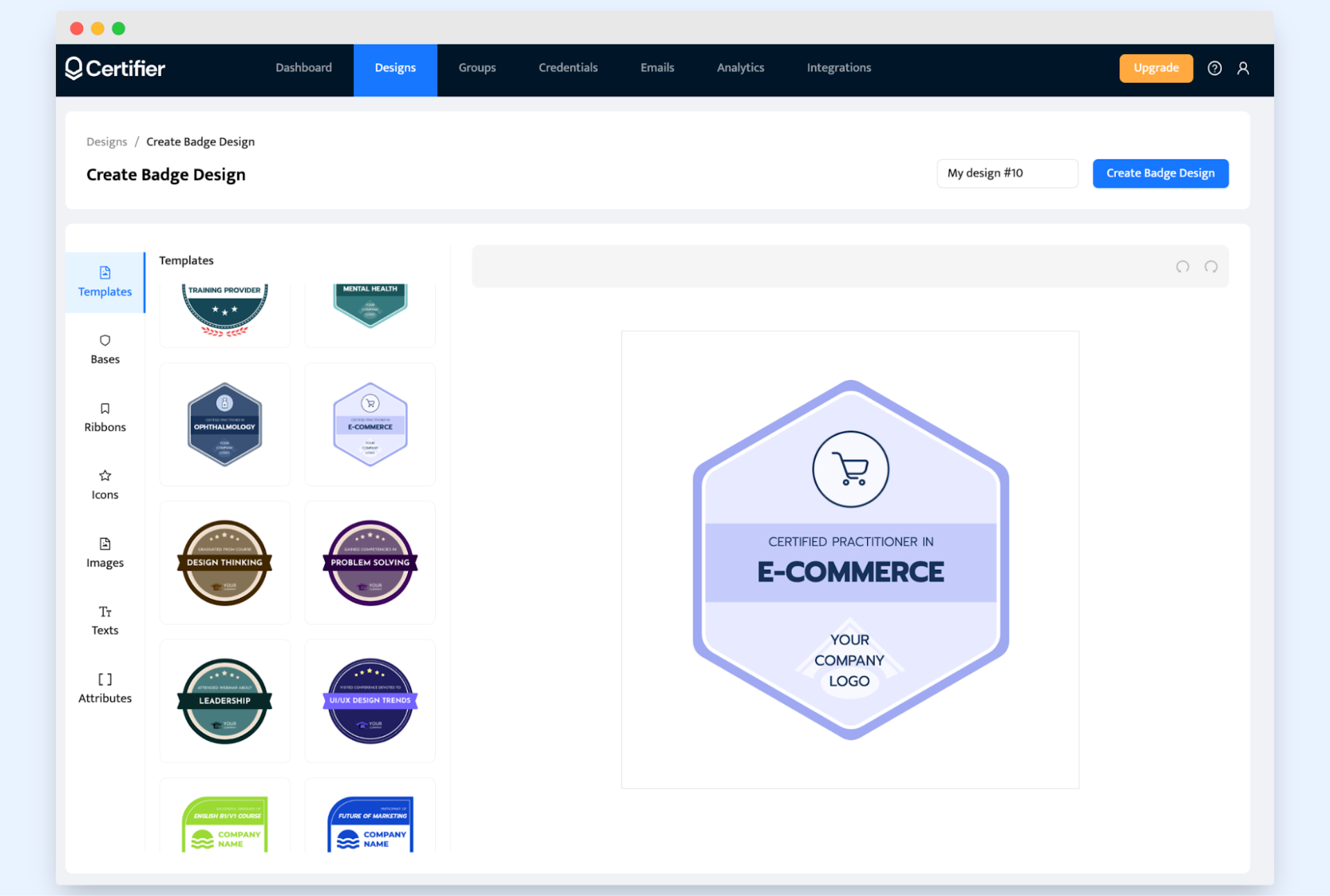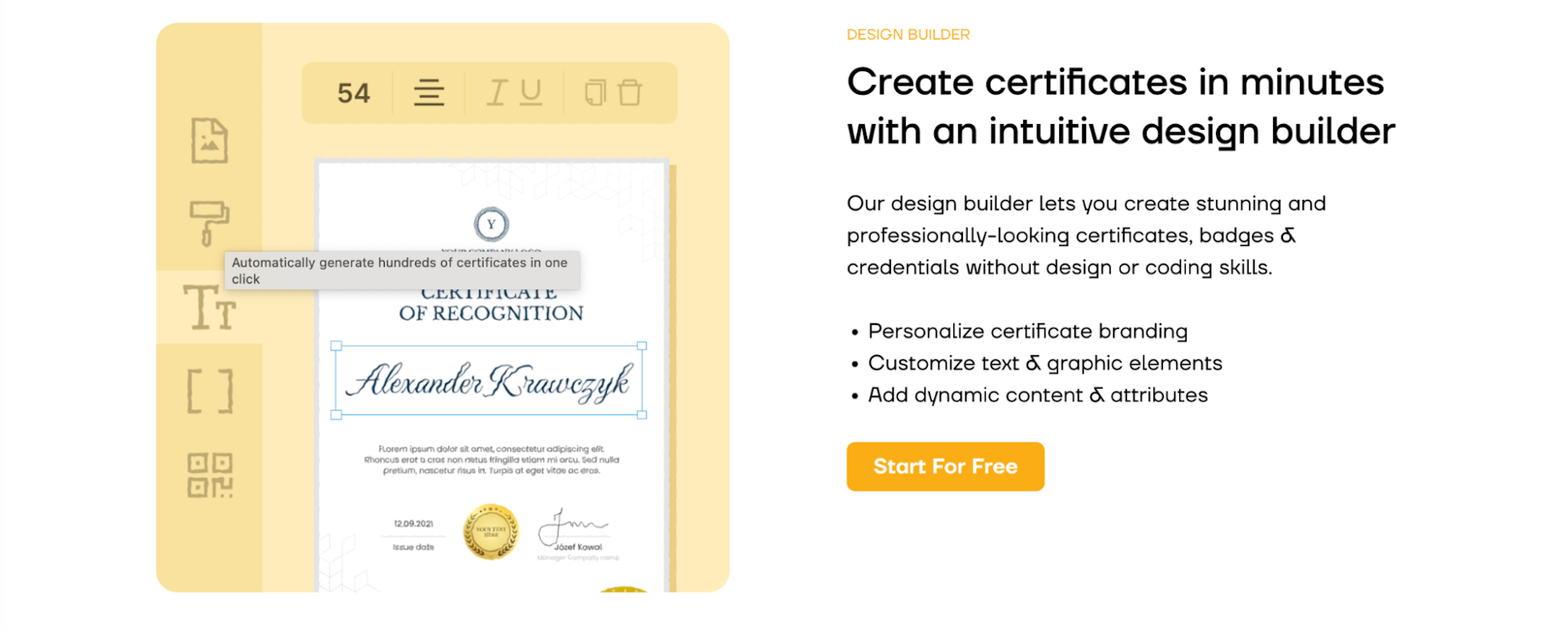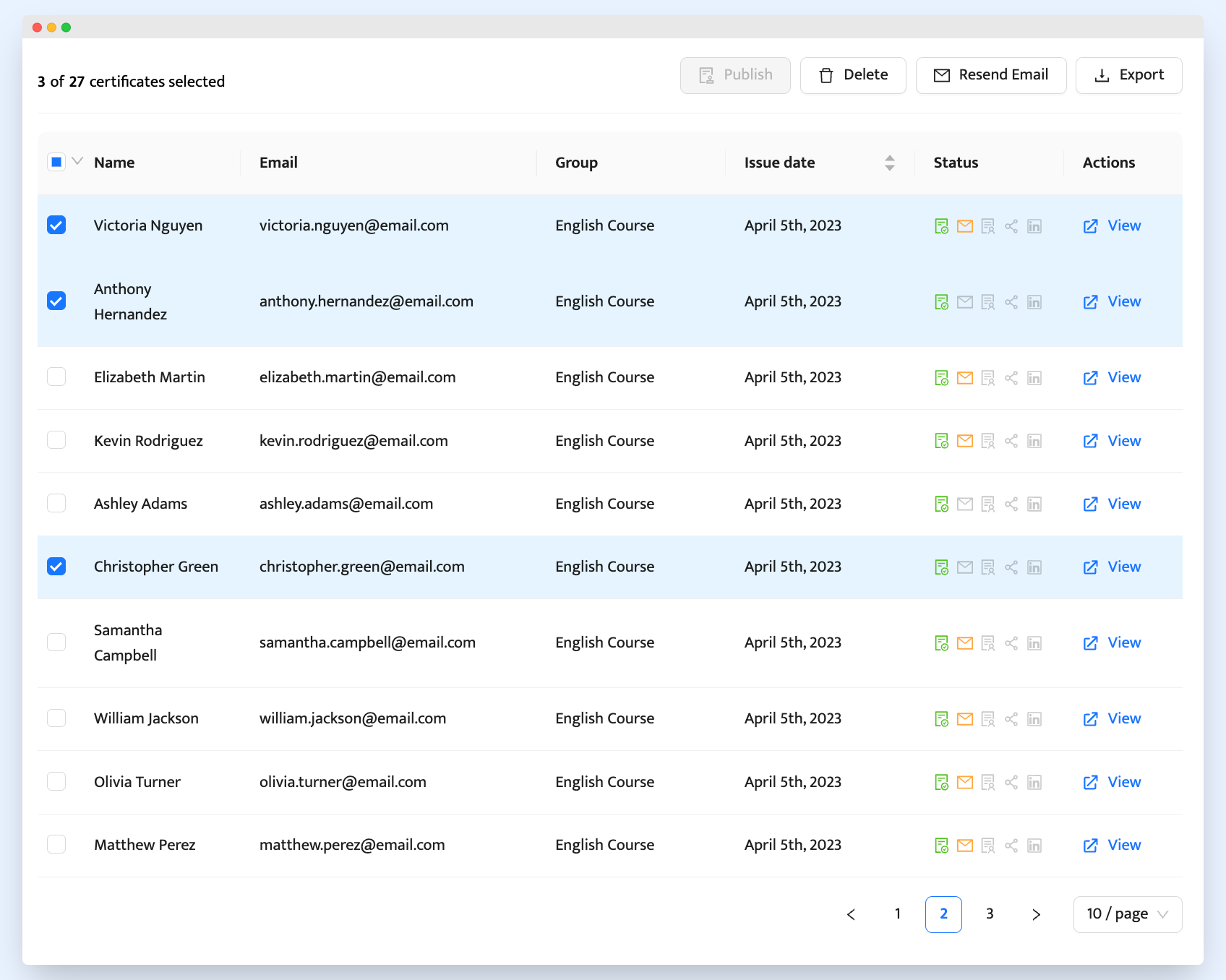Trusted by:
13 Actionable Strategies to Boost Engagement in Corporate Training
Make your corporate training a thrilling journey, not a snooze-fest. Here are actionable tips that breathe life into long learning sessions. Certifier is on the list!
AuthorSergey Butko
Updated: April 16, 2024
14 min read

Author
Sergey Butko
Updated: April 16, 2024
14 min read
Trusted by:
How to turn humdrum corporate training into a transformative experience?
The answer lies in engagement.
Who wants to sit through an endless slideshow when you could be actively involved in an immersive, interesting learning process?
But don't think it's as easy as flipping a switch.
There are plenty of obstacles that stand between your current training models and a truly engaged workforce – but the payout, let us say, is more than enough.
Why should you bother increasing engagement in corporate training?
With corporate training is like exercise – you know you should do it, but it’s often hard to stay motivated to stick with it. You need to consistently push yourself to reach the results you want.
It is likely that your company's employees feel the same way. Let's take a look at some stats.
92% of employees believe that well-planned employee development programs have a positive impact on their level of engagement. (Training Industry Report)
In companies with strong interactive training programs, income per employee increases by 218%, and profit margins increase by 24%. (Business Training Experts)
It can be beneficial to get creative and find ways to make the training process more interesting and enjoyable. In the long run, it's good for your company as a whole and your employees as individuals.
Here are some more reasons why you should optimize corporate training to boost engagement.
Improved learning business outcomes and more effective learning – Employees who are engaged are more likely to absorb and retain training information. They are also more open to new ideas and approaches.
Better employee performance and increased productivity and efficiency – Engaged employees tend to perform better in their roles, as they are motivated to apply the newly acquired skills and knowledge to their tasks.
Higher retention rates = lower onboarding costs and more experienced employees overtime – training that is engaging and enjoyable will motivate employees to complete the corporate training programs and attend professional development courses. It creates loyalty and commitment within the workspace, thereby reducing turnover and increasing job satisfaction!

13 Best engagement strategies for corporate training (tested!)
Let's get down to brass tacks. Here are some strategies you can put into action today to supercharge engagement in your corporate training sessions. Each of them is different, so for sure, you find the one that fits your corporate training market. Mix them up for even better results!
#1 Blend learning models
Blended learning combines the powers of traditional face-to-face instruction and online learning. The goal? To provide a more flexible learning experience. Allow your employees to choose how they want to participate in training courses – in person or online, both groups can participate equally (as long as you provide effective tools to do so).
Provide adequate equipment for online learning. Find a meeting platform that is easy to use and suits their needs, e.g., Google Meet
Ask your employees to take an active role in online meetings with cameras and microphones on.
Integrate digital skills with traditional in-person seminars to help employees develop their interpersonal skills.
Example: Consider a scenario in the IT sector where this strategy is implemented. Employees could opt for scheduled traditional classroom-style training sessions to master coding fundamentals while also engaging in online modules (whenever they want to). It helps them both improve their coding skills and keep up with the changing technological landscape. As a result, they are able to develop more innovative solutions.
#2 Game on for learning
Turn work into play! Introducing gamified elements can transform dull training sessions into exciting challenges. Gamification, or the use of game-like elements in atypical situations, can do wonders. You don't just need to turn your training into a competition. The goal is to make learning more engaging by using elements like badges, leaderboards, rankings, and challenges.
Develop point systems that track hours of training, badges that highlight leadership skills, and scoreboards that spark friendly competition.
Invest in game-based learning platforms that help you manage gamification within your organization.
Badges don't have to take a long time to make! Create them with Certifier in a matter of minutes. Choose the template, adjust them a little, and send them out to the participants.

Example: Let's say you're learning about customer service. As you complete different parts of the course, you unlock badges that show your progress. It's like collecting stars in a game. And when you finish the whole training, you get a "Customer Service Champion" badge. It's a bit like winning a trophy for being really good at something! It’s a great way to motivate your employees to learn via the active-learning model and make regular progress.
#3 Integrate interactive learning tools
Imagine sitting through a movie where you can interact with the characters, influence the plot, and even change the ending (it’s something that Netflix is already trying to do). That's the kind of captivating experience interactive learning digital tools can bring to corporate training. So why not spice up employee training with some fun quizzes or simulations?
Use quizzes and polls during training sessions to encourage active learning and development of employees.
Engage learners with interactive videos where they can make choices to practice their effective decision-making.
Example: During a diversity training session, a quiz can pop up after every segment, helping employees remember key features and get soft skills on how to deal with different individuals in a team. These quizzes make learning fun and effective, like a mini-challenge at every step.
#4 Take advantage of microlearning techniques
Remember trying to study for an exam and forgetting half of what you learned the next day? That's why microlearning techniques are so effective in intensive training. By breaking down information into bite-sized chunks, learners can easily digest the material and remember it better.
Divide lengthy courses into more manageable, shorter segments. In this way, learners are not overwhelmed and are able to absorb the material effectively.
Leverage tools like flashcards or mobile apps for swift knowledge check-ins. It boosts memory retention.
Promote the idea of brief, frequent training sessions rather than lengthy marathons.
Example: Consider a situation where employees need to learn about leadership development. Instead of exposing them to a lengthy 2-hour lecture, divide it into four 30-minute sessions spread across a week. Gradual learning lets employees absorb and apply each concept before moving on.
#5 Motivate with rewards
Motivation often lies in appreciation. Sweeten the learning pot. Rewards drive motivation and give employees something tangible for their efforts. Take your appreciation a step further by providing attractive rewards as employees accomplish significant milestones, e.g., after completing essential modules.
From bonuses to gift cards, offer meaningful rewards that can light up employees' motivation, showing that their effort and growth are truly valued.
Use certificates to visibly honor skills and make employees feel valued.
Example: Let's say employees triumph in a project management program. In addition to a certificate of achievement, colleagues receive an invitation to a special lunch as a way to celebrate their achievements together. This is a great reason to tighten up the company's bonds and create a healthy culture.

Want to give your team the recognition they deserve? Use Certifier a user-friendly certificate maker that turns achievements into meaningful certificates without graphic design skills. Whether it's finishing a course, mastering new skills, or hitting a milestone – Certifier helps you celebrate your company's successes. Try out Certifier in action.
#6 Apply real-world scenarios and case studies
The theory is good, but the practice is better. Using real-world scenarios and case studies in your training is like taking your learners on a field trip. It lets them see how the concepts they're learning apply in the real world.
Examine in-depth case studies from industrial companies, which allow employees to grasp the concepts and gain valuable knowledge.
Role-playing exercises can breathe life into business scenarios, creating memorable learning experiences.
Discuss actual challenges faced by the company and how to navigate them.
Example: Think about a sales team learning negotiation skills. Instead of just talking about it, they could role-play a scenario where they negotiate with a tough client. It lets them experience real-world challenges and practice their skills in a safe environment. Employing hand-on practices in corporate training will boost engagement and guarantee that employees are able to apply their newly acquired knowledge to make more informed decisions. Through practice, employees can gain a deeper understanding of the material and how to apply it to real-world situations.
#7 Learn together, grow together
If two heads are better than one, imagine what a whole team can accomplish! A peer learning environment fosters teamwork and employee learning (and leads to new ideas and insights!).
Set aside dedicated times for team members to exchange feedback and opinions.
When facing challenges or complex tasks, encourage the team to brainstorm and problem-solve together.
Create small learning circles or study groups where team members can explore a specific topic together.
Example: A fractional content team aims to brainstorm a new campaign. Instead of each person working in isolation, they gather for a peer-learning session. As they discuss their unique approaches and insights, a wave of ideas forms. Besides creating a powerful campaign, this collaborative effort also strengthens team bonds.
#8 Personalize the learning experience
No two learners are the same. Some employees are visual learners, some prefer text, and others learn by doing. Personalizing the learning experience to match the learning styles of your employees can make the learning process more enjoyable.
Allow employees the autonomy to explore areas in line with their career goals.
Understand that learning styles differ and offer varied formats ranging from interactive sessions to deep reading.
Example: In a sales team, consider a situation where personalizing the learning experience involves a salesperson who thrives as a visual learner. They could engage in interactive product demos, video case studies of successful sales, and visually appealing infographics showcasing sales techniques. In contrast, another salesperson who learns best by doing could participate in role-playing exercises and simulated sales scenarios. By catering to each person's learning style, you create an environment where they flourish, resulting in improved performance and a motivated team.
#9 Spread the spark to share the experience
Sharing is caring. Encourage employees to pass on their knowledge and experiences. Also inspire them to share their progress by creating an environment where they can easily do so. And here's the secret key: easily shareable certificates that empower employees to proudly showcase their growth.
Organize regular sessions where employees share their experiences, insights, and lessons.
Mentorship programs can bridge gaps, connecting seasoned professionals with newer entrants.
Make the rewards easy to share on platforms like LinkedIn (employees can share Certifier certificates with one click and you can track the shares!)

Example: Sarah, a young graphic designer, completes a course on advanced digital illustration. With an easily shareable certificate, she broadcasts her achievement on LinkedIn. The response is amazing – colleagues admire her dedication, clients are intrigued by her expertise, and conversations flourish. Sarah's journey becomes a source of encouragement, and others follow suit.
#10 Use the magic of storytelling
A well-told tale can make any topic resonate. For years, stories have served as tools for passing on knowledge. The use of storytelling in your training not only makes it more interesting but can also help make complex concepts easier to understand.
Infuse training with stories of real employees, their challenges, successes, and journeys.
Relatable anecdotes can ground abstract concepts, making them resonate more deeply.
Invite guest speakers who can share their personal experiences and insights
Example: Take the case of cybersecurity training. Rather than just presenting technical skills, tell the story of how an employee was attacked by a phishing scam and the steps taken to protect the company's information. A narrative like this emphasizes both cybersecurity's importance and its real-world consequences, making it both relatable and impactful to learners.
➡️ Boost corporate training engagement with employee of the month certificates. Inspire yourself with modern, ready to use templates.
#11 Provide self-directed training options
Give a man a fish, and you feed him for a day. Teach a man to fish, you feed him for a lifetime. The same goes for learning. Learning on one's own helps employees take charge of their own development, making the learning process more meaningful and engaging.
Offer a well-equipped library on a plethora of topics, allowing employees the freedom to chart their course.
Celebrate independent research, fostering a culture of curiosity and in-depth understanding.
Develop modular content that focuses on specific skills or competencies.
Example: The cost of industry books can be high. Provide a free virtual learning library accessible to all team members. It can be a collection of e-books, audiobooks, research papers, and educational websites covering an array of subjects, from technology and leadership to wellness and creativity.
#12 Nurture a growth mindset
A growth mindset is like a superpower that turns challenges into chances. It's the belief that you can get better at anything with effort. By nurturing a growth mindset, you help your team see problems as paths to progress, not roadblocks.
Highlight mistakes not as failures but as invaluable learning opportunities.
Create an environment where curiosity isn't just accepted but celebrated.
Example: Imagine in a marketing brainstorm, someone suggests an idea that didn't work out. Instead of hiding it, the team brings it up in the next meeting. They chat about what they learned and how it shaped their new, even better idea.
#13 Make learning analytics work for you
What gets measured gets managed. You've set the stage, implemented the strategies, created the right environment – but how do you know if it's working? That's where metrics come in. They can help you evaluate engagement, identify areas for improvement, and keep the momentum going.
Analytics tools can offer deep insights into engagement, efficacy, and areas of improvement.
Real-time feedback allows for course corrections, ensuring training remains effective and relevant.
Example: Consider a scenario where a company launches a comprehensive development program. Anticipation is high, and the initial response is enthusiastic. However, as the program progresses, signs of unexpected challenges begin to show up. Workshop attendance starts dwindling, and completion rates for online modules fall below expectations. The company decides to use analytics tools to uncover the root causes of low engagement and identify areas to make the training perform better.
Signs of creating a good corporate training environment that drives engagement high
The best learning strategies in the world won't do much good if your corporate culture doesn't support engagement. How well are you at that? Check it out with this list.
Culture of collaboration and team building
Teamwork makes the dream work – and that applies to learning as well. Collaborative and team-based training can result in more engaging and effective training. Imagine a training ground where employees come together, share insights, and master their skills together. If you find this dynamic at play, you're on the right track.
Open communication and regular feedback
Keeping communication open and providing regular updates about employees' performance is like the checkpoints on the highway to engagement. They keep your training on track and help you identify any roadblocks that may hold your employees back. Best if your training includes regular updates and chances for participants to voice their thoughts. Growth takes place here.
Flexibility in learning schedules and formats
No one likes to be put in a box. Offering flexible learning dates and structures can help accommodate different learning styles and preferences. If your training courses adjust to various work scheduling needs and adapt to different learning styles, you're cultivating engagement diversity. Employees feel more freedom, and they don’t afraid to take risks and start corporate training.
Matching training opportunities for professional growth
A positive training environment doesn't provide corporate training programs for the sake of learning. Rather than throwing random training modules, such companies align training opportunities with the individual aspirations of its employees. All of these create a harmonious synergy between personal ambitions and organizational development goals.
Safe and inclusive learning environment
A supportive learning environment is like fertile soil – it provides the ideal conditions for growth and career development. If your training space encourages questions, welcomes ideas, and supports risk-taking, good job! You enable learners to bloom with confidence.
The path to highly engaging corporate training
So, there you have it – a range of strategies to increase corporate training engagement.
From blended learning to gamification, from peer learning to certification, there's a whole world of opportunities to explore. But remember, engagement isn't a one-time thing, it's an ongoing process. So, keep your eyes on the road and enjoy the ride!
Start your journey with certificates. Choose from a variety of corporate training certificates available. Join for free, and do not miss a chance to improve your employees’ engagement.

Sergey Butko
Tech entrepreneur. Forbes 30 Under 30 Europe. At Certifier, Sergey’s work focused on revolutionizing the way credentials, certificates, and badges are issued and managed through cutting-edge APIs and software infrastructure.
Sergey Butko
Tech entrepreneur. Forbes 30 Under 30 Europe. At Certifier, Sergey’s work focused on revolutionizing the way credentials, certificates, and badges are issued and managed through cutting-edge APIs and software infrastructure.
Share this article